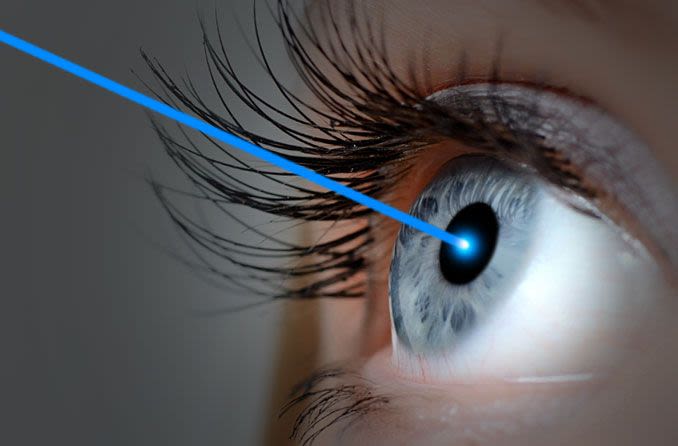The LASIK procedure : A complete guide

LASIK (laser-assisted in situ keratomileusis) is the most commonly performed laser eye surgery to treat myopia (nearsightedness), hyperopia (farsightedness) and astigmatism.
Like other types of laser refractive surgery, the LASIK procedure reshapes the front surface (cornea) of the eye to enable light entering the eye to focus on the retina without glasses or contact lenses.
LASIK typically is pain-free and requires only about 15 minutes to treat both eyes. Vision improvement is immediate and often stabilizes in as little as 24 hours.
The LASIK procedure
There are three essential steps to a LASIK procedure:
A mechanical surgical tool called a microkeratome or a femtosecond laser is used to create a thin, circular flap in the cornea. The surgeon then folds back this hinged flap to access the underlying cornea (called the stroma).
An excimer laser is used to reshape the corneal stroma. This highly specialized laser uses a cool ultraviolet light beam to remove ("ablate") microscopic amounts of tissue from the cornea to reshape it so it more accurately focuses light on the retina for improved vision.
The corneal flap is laid back in place, where it adheres to the corneal stroma without stitches.
What to expect
Before LASIK. Your eye doctor will perform a thorough eye exam to determine if you are a good candidate for LASIK vision correction.
During this exam, the surface or your eye will be examined to make sure you have no unusual risk of dry eyes after LASIK.
An automated instrument called a corneal topographer will be used to create a detailed, point-by-point map of the shape of your cornea. An additional measurement called a wavefront analysis of your cornea also may be performed to help you achieve the best LASIK outcome possible.
You should stop wearing contact lenses for a period of time advised by your doctor (typically at least two weeks prior to LASIK). This is important because contact lens wear can alter the natural shape of your cornea and could affect the outcome of your procedure.
During LASIK. Immediately before your LASIK surgery, numbing eye drops are applied to your eye to prevent any discomfort during the procedure. Your doctor may also give you some medication to help you relax.
Your eye will be positioned under the laser, and an instrument called a lid speculum is used to keep your eyelids open.
A suction ring is applied to the front of your eye to prevent eye movements or loss of contact that could affect the quality of the corneal flap.
After the corneal flap is created, the surgeon then uses a computer to adjust the excimer laser for your particular prescription. You will be asked to look at a target light for a short time while he or she watches your eye through a microscope as the laser sends pulses of light to your cornea.
The laser light pulses painlessly reshape the cornea, but you may feel some pressure on your eye. You'll also hear a steady clicking sound while the laser is operating. The laser treatment itself takes only about a minute.
Immediately after LASIK. Upon completion of your LASIK surgery, your surgeon will have you rest for a bit. You may feel a temporary burning or itching sensation immediately following the procedure.
After a brief post-operative exam, someone can drive you home. (You cannot drive after LASIK until your eye doctor sees you the following day and confirms your uncorrected vision meets the legal standard for driving.)
You should expect some blurry vision and haziness immediately after surgery; however, for most people, vision improves immediately and stabilizes within a few days.
You may be able to go to work the next day, but many doctors advise a couple of days of rest instead.
Generally, you will return to see your eye doctor or your LASIK surgeon the day after surgery.
At this visit, he or she will test your vision to make sure you are legal to drive without glasses or contact lenses. (In most states, this requires uncorrected visual acuity of 20/40 or better.)
Follow your doctor's instructions and take any medication prescribed. Also, avoid rubbing your eyes, as there's a small chance this could dislodge the flap until it heals and adheres more securely to the underlying cornea.
Long-term. Laser eye surgery offers numerous benefits and can dramatically improve your quality of life. Most people achieve 20/20 vision or better after the surgery, but outcomes vary from person to person.
You may still need to wear glasses or contact lenses following laser vision correction, though your prescription level typically will be much lower than before.
If you have mild residual refractive error after LASIK and you want sharper vision for certain activities like driving at night, prescription lenses with anti-reflective coating often are helpful.
If you are sensitive to sunlight after LASIK, ask your eye doctor about prescribing glasses with photochromic lenses.
While the procedure has an excellent safety profile, LASIK complications can occur and may include infection or night glare (starbursts or halos that are most noticeable when you're viewing lights at night, such as while you're driving).
A small percentage of people need a LASIK enhancement, or "touch up" procedure, a few months after the primary LASIK surgery to achieve acceptable visual acuity.
And you still will need reading glasses once you reach your 40s, due to a normal age-related loss of near vision called presbyopia.
Page published on Tuesday, December 31, 2019






